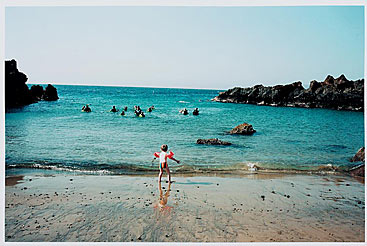
Born in 1962 in Berne (CH)
Lives and works in Zurich (CH) and Paris (FR)

1996-1997
Colour photograph, C-Print
75 x 105 cm
Year of Purchase: 1998
The photographic series that Istvan Balogh has been building up since the early 1990s are to be seen in terms of doubt and suspicion. One of them, entitled L’Âge de Fer (1992-1997), makes explicit reference to Ovid’s Metamorphoses, in which the Iron Age is the troubled period that follows on from the fullness of the golden age, but also the period in which the human community is founded. So it is the beginning of time, the origin of History, built on a loss, and thereby generating an infinite quest for meaning. Carefully composed and staged with walk-ons, like most of Istvan Balogh’s work, the photographs of L’Âge de Fer tend towards the allegorical picture, each detail of which can be read and interpreted as a sign, a clue enabling a path to be found to a meaning that remains equivocal however.
In a classroom, while a pupil is wiping the blackboard on which the word ‘Aufklärung’ is still written, one of his fellow pupils moves up with clenched fists to the impassive teacher’s desk. Is this perhaps a veiled, instinctive rebellion against a positivist system of interpreting the world, like the Romantics of Sturm und Drang against the Age of Enlightenment? In another image, a woman puts her hand in an avatar of the ‘Mouth of Truth’ sculpture used as an oracle, which this time however seems to remain silent.
Istvan Balogh’s photographs depict, as Jean-Marc Huitorel puts it, ‘the world in its crucial expectation’1, they often seem to record, not the decisive instant that marked the history of the photograph, but the awaiting, the approaching of a forever unknown and unpredictable sign or event, a period of latency tinged with worry, the final moment when all interpretations remain open, before the mystery is perhaps solved. The series In the meantime (1996-1997), the title expressing both the interval and simultaneity, adds further complexity to Istvan Balogh’s images. Varied and polysemic, the photographs in this series refer back to a collective imagination, to a set of reminiscences able to bridge the gap between reality and fiction. The work purchased by the Frac shows a child preparing to bathe in a creek, but stopped in his tracks and stunned at the sight of a dozen frogmen with masks and snorkels, apparently coming ashore.
From the Loch Ness monster to the shark in Jaws, and not forgetting Captain Nemo and his Nautilus, what rises up from the opaque waters is the object of primordial terror, like fears of monsters looming up in the dark or rabid dogs in deserted spots. Istvan Balogh deliberately holds his image in an indeterminate state, short of any reassuring interpretation, at the precise instant of catching the character coincides with the ‘impressing’ of the viewer by the image.
François Piron
1 Jean-Marc Huitorel, in catalogue du Mois de la photographie, Reims, 1996